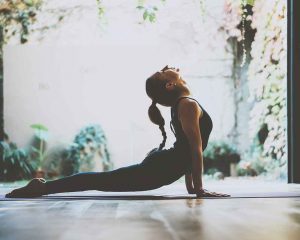It’s New Year’s Day, and your resolution is to work out every day, starting tomorrow. You hit the ground running and dedicate an hour to hardcore workouts every day for a week. And then work gets really busy, you’re not sleeping enough, you forgot you had to travel to your friend’s wedding is next weekend, your bed is super comfortable…and before you know it, you can’t remember the last time you exercised. Sound familiar? It happens to all of us.
It’s no secret that working out will improve your cardiovascular health, help you accomplish your weight loss goals, manage metabolic disorders, and overall make you feel happier and more energized. Yet so many of us struggle with how to make a workout plan that we can actually stick to.
It’s impossible to harness the benefits of exercise if you just work out for a week. So, what’s the secret to making a workout routine that ultimately becomes a habit?
Here are 9 tips- with crucial advice from a fitness professional -for making a strategic workout plan that helps you get in shape and stay in shape.

1. Schedule In Your Workouts
Life can get hectic, and it’s easy to forgo a workout if you don’t pre-plan time for one. Hoping that a workout will happen naturally can be risky, because it’s easier for our minds to justify excuses without a set plan.
It helps to have time set aside on a regular basis to dedicate to physical activity. Try writing in your workout times in a planner for the upcoming week. Even the act of weekly scheduling is creating a mental habit that sets you up for success. As you start your week, you have a game plan that raises the likelihood of working out.
At the same time, it’s ok if your schedule changes sometimes. Maybe you had intended to work out in the morning and instead, you ended up working out in the evening. That’s ok! As you find your rhythm with exercise, you will learn how to adapt to your new routine and what times are more conducive to completing a workout.
2. Start Slow and Set Personal Goals
If you currently have a sedentary lifestyle, do not start with intense workouts every single day of the week. This is simply not sustainable and will lead to quick burnout, leaving you back at square one.
Instead, start by setting weekly, bite-size goals. These goals may at first be as simple as making it to the gym three times this week. Accomplishing these weekly goals builds confidence and over time, you can set longer-term goals. These bigger goals might be something like running a 5-mile race in under an hour or completing an obstacle course.
Track Your Progress
Additionally, make sure you track your progress as you achieve goals that you set for yourself. You could try writing a daily journal entry- even one sentence could be sufficient. An audio journal could also be a quick and convenient way to follow your progress. Checking in with yourself helps you measure your progress, recognize your goals, and assess what needs to be done to attain the next goal.
The importance of recording your progress is even backed by science. Researchers at the University of Sheffield and the University of Leeds in England and the University of North Carolina at Chapel Hill conducted a study analyzing the impact of monitoring progress on the attainment of goals. Outcomes suggested that assessing goal progress on a more frequent basis could promote goal achievement. (1)
3. Create a Fun Workout
Inconsistency with exercise often stems from the dread we have about how boring or painful a workout may be. If only working out was more fun, we’d do it so much more often, right? Luckily, there are ways to reframe your mindset and make workouts more enjoyable.
“It’s important to find something active you enjoy because otherwise, it won’t stick. If you find something you enjoy, you are way more likely to do it. I like to say that exercise is not a punishment, and I truly believe everyone can find something active they enjoy. Maybe it’s a sport, hiking, dancing, or even doing yard work,” says fitness professional Amanda Best, who holds a Master of Science in Sports and Applied Exercise Physiology and is a Certified Strength and Conditioning Specialist. Amanda is an experienced personal trainer and has established her own brand, Thrive Alive, that revolves around how to make exercise a fun part of a balanced and fulfilled life. (2)
Instead of thinking about exercise as a chore that you need to check off your to-do list, make it into an activity that you actually look forward to. The best workout is one that you find fun and motivating.
4. Remember that Playing Isn’t Just for Kids
This goes hand-in-hand with #3. Amanda explains how adults can play too, and she shares some of her go-to’s for incorporating games into a workout: “There are so many ways to infuse games like cards, monopoly, Jenga, and dice into workouts. Playing workout games in a group setting is ideal – the teamwork and added competition makes it more exciting and fun.”
Take any opportunity you have to move around and have fun. This way, it’ll be easier to make physical activity a part of your day. As example scenarios, let’s say you’ve taken your kids to the park or perhaps you’re walking your dog past a playground. As adults, we may be naturally inclined to sit on the sidelines and skip out on “playing.” But why not try to do a few rounds on the monkey bars? Plus, hanging on the monkey bars exercises lots of muscle groups throughout your arms and core.
5. Make Exercising Social
Some people may prefer to designate workouts as alone time, which is great if that works! However, for many of us, a lonely workout is downright boring and can squander motivation.
Amanda also emphasizes the fundamental human need for social connection for fulfillment, a concept summed up by this TED Talk on the 75-year happiness study conducted by Harvard University. (3)
Amanda describes how “we depend on solid relationships to live a happy and healthy life. That’s why working out in groups is so much more fun than working out on your own. When engaging in social interaction, dopamine is released on a neurological level, and we feel more content and connected.”
Amanda explains how the positive impacts of strong social bonds extend to the gym. “Gyms and fitness programs that create opportunities for people to build authentic relationships and a community with others have a powerful and positive influence on people’s health and habits. People who feel connected at a gym are so much more likely to continue and recruit their friends. Think of CrossFit; it seems almost cult-like because there is such a strong sense of community around their fitness program, which encourages consistency. Also, clients who have a great relationship with their trainer are more likely to stick to their routine in the long-run. Relationships, social interaction, and exercise are synergistic on many different levels and promote long-term health and happiness,” she says.
Plus, exercising with others can help hold us accountable. Planning a workout with friends means we’re less likely to make excuses and therefore, less likely to miss a workout.
6. Have At-Home Workouts Prepared
Certain obligations and unexpected things may come up, and sometimes the day will just be too crazy to spend time going all the way to the gym, or making it to that yoga class, or meeting a friend in the park. If you are tied to your house, having an at-home workout plan ready to go will help you follow through on exercising. Adapt to the unexpected and don’t let life’s demands keep you from fulfilling your goals.
Sample Home Workout Plan
It may help to have a few pieces of equipment handy that you can whip out of the closet on those busy days:
- Resistance bands: Tighter bands offer more resistance and simulate heavier weights, while looser bands offer less resistance and simulate lighter weights.
- Set of dumbbells: These don’t need to be very heavy. If you are new to weights, using five-pound weights or 10-pound weights is a great place to start.
If you don’t have any equipment, don’t sweat it! Bodyweight exercises effectively build muscle too.
- Do a quick warm-up of burpees: These are great to get your heart rate up in no time. To do a burpee, start in the push-up position. Hop to your feet, and jump in the air and reach both hands above your head. Complete three sets of 10 burpees, taking a moment in between to catch your breath.
- Lunges (with or without weights): This works your lower body muscles, specifically your glutes and quads. Complete three sets of lunges across your room and back, taking a little time in between sets to breath.
- Squatting and side-stepping: This can be done with or without bands. If using resistance bands, fit the band around your ankles. When squatting, make sure your back is straight to maintain good form. Clasp your hands in front of you, and sidestep slowly and deliberately. As you did with lunges, complete three sets across your room and back.
- Sit-ups (with or without weights): This move is a spin on the classic sit-up and strengthens muscle groups in your core and arms. When lying down preparing for a sit-up, make sure your knees are bent and outstretch your arms while holding a weight above you. The weight should be approximately positioned so it is above your chest. Hold the weight above your head as you follow through on your sit-up. Complete three sets of 15 weighted sit-ups.
- Calf raises (with or without weights): Start by standing up straight, holding a weight in each hand. Let your arms hang in front of you, holding the weights. Shift your weight so your standing on your tiptoes, and then slowly lower yourself. Complete three sets of 15 toes raises.
If you’re looking for more ideas, Heidi Powell is a fitness professional and busy mom of four who creates work out plans and recipes. For more information on creating a full-body workout at home, check out Heidi Powell’s page for great at-home, total-body workouts. (4)
7. Have Only 5 Minutes? Work Out for 5 Minutes.
A common practice is abandoning workout plans if you can’t dedicate a full hour to it. Time should never be an excuse because a short workout can be an effective workout! These 5-minute workouts can be utilized to target and develop a specific muscle group or even complete a total body workout.
High-intensity interval training (HIIT) makes it possible to maximize those few minutes you have for exercise and get your heart rate going. HIIT exercises require quick bursts of high-energy output. For example, completing a series of sprints across your yard or down the block on your street is a fast way to burn calories and increase your cardiovascular fitness.
8. Eat Right
If you’ve ever heard the expression “abs are made in the kitchen,” then you’re familiar with the importance of nutrition in muscle-building. If you don’t eat foods that are rich in protein and amino acids, fruits, vegetables, and whole grains, it will be challenging to build muscle. Eating junk will just dampen your energy levels and make you feel worse. Processed and packaged foods filled with preservatives, saturated fats, sugar, sodium, artificial dyes, chemicals, and empty calories can make you feel sluggish.
Chowing down on a variety of whole foods will boost your mood and energy, balance your hormones, increase your muscle mass, and actually help you feel more motivated to exercise.
9. Alternate Strength Training and Cardio
You can alternate strength training and cardio in one workout, or you can alternate each session. Strength training is an anaerobic exercise, while cardio is aerobic exercise.
Cardio is referred to as an aerobic exercise because your body requires more oxygen to sustain activity. Cardio exercises include activities like dancing, running, jogging, swimming, and biking. Participating in these activities builds your endurance and strengthens your cardiovascular system. Over time, your heart, lungs, and blood vessels will become increasingly efficient at delivering oxygen to all of your muscles and organs.
Strength training categorized as an anaerobic activity because your endurance is not tested. Strength training, or resistance training, is vital for building muscle. As you lift weights, your muscles will tear, prompting your body to repair and strengthen your muscles in the recovery period following a workout.
Alternating strength training with cardio is relevant when incorporating rest days into your routine. If you engage in strength training each day, try to avoid intense strength training that targets the same muscle groups two days in a row. For example, if you focus on the upper body one day, turn your focus to strengthening the lower body the next day. Recovery periods are necessary for encouraging muscle growth. If you want to give all of your muscles a day off, this break is a great chance to do some light cardio instead.
Conclusion
Though forming a habit of exercising can seem daunting, it is possible to make a sustainable workout plan. Making plans, setting goals, incorporating games, and working out with friends will help you form exercise habits so can you achieve your health and fitness goals.
References:
1. https://www.ncbi.nlm.nih.gov/pubmed/26479070
2. https://thrivealivefit.blogspot.com/
4. https://heidipowell.net/11266/top-ten-at-home-exercises-for-total-body-toning/























